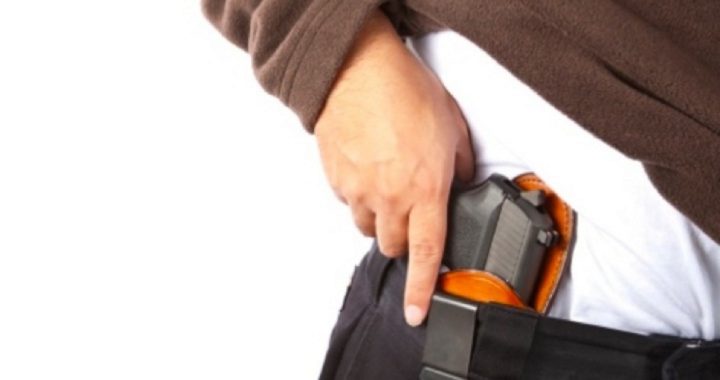
The decision rendered by the Ninth Circuit Court of Appeals February 13 resulted in gasps of dismay from gun control advocates and cheers of delight from Second Amendment supporters. In writing for the 2-1 majority in the case of Peruta v. County of San Diego, Judge Diarmuid O’Scannlain, in his 70-page opinion, said:
We are called upon to decide whether a responsible, law-abiding citizen has a right under the Second Amendment to carry a firearm in public for self-defense….
Because the Second Amendment has always been an individual right to defend oneself … states may not destroy the right to bear arms in public under the guise of regulating it.
At issue was the requirement, enforced by the San Diego County Sheriff William Gore, that an applicant for a concealed weapons permit must demonstrate “good moral character,” must complete a specified training course, and establish sufficiently “good cause” for the sheriff to issue the permit. The judge noted that the state law the sheriff was enforcing required him to evaluate “good cause” on a case-by-case basis looking particularly at “situations related to personal protection … [but concern for] one’s personal safety alone is not considered good cause.”
The requirements are onerous: An applicant has to provide documentation supporting and elaborating on their good cause, such as restraining orders, letters from law enforcement agencies and other sources proving that he had a sufficiently pressing need for self-protection, proving to the sheriff’s satisfaction that these are “circumstances that distinguish [him] from the mainstream,” according to the law. In other words, the sheriff was under no pressure or requirement to issue concealed carry permits, and so, except in rare circumstances, he didn’t.
This frustrated the plaintiffs in the case, Edward Peruta, Michelle Laxson, James Dodd, Leslie Bucher, and Mark Clearly, who were either denied concealed carry permits or simply decided not to apply in the first place, knowing that their applications most likely wouldn’t be approved. They were joined by the California Rifle and Pistol Association Foundation (CRPAF) and the National Rifle Association (NRA), which helped fund the attorneys prosecuting the suit. The complaint was simple: Peruta was being denied his freedom guaranteed under the Second Amendment to keep and bear arms for the purposes of self-defense because the “good cause” requirement kept him from doing so.
O’Scannlain relied heavily on the Heller and McDonald cases already decided by the Supreme Court in 2008 and 2010 respectively, noting that Heller in particular “codified a pre-existing, individual right to keep and bear arms and that the “central component of the right” is self-defense. He then noted that McDonald completed the loop that such a right guaranteed by the Second Amendment applied not only to the federal government but to the states as well under the Fourteenth Amendment.
In his analysis, O’Scannlain did something remarkable: He sought to determine the “originalness” or the original intent of the Founders. For his argument he relied on the Heller case in which the Supreme Court held that “Constitutional rights are enshrined with the scope they were understood to have when the people adopted them, whether or not future legislatures or (yes) even future judges think that scope too broad.” The judge didn’t try to twist meanings or shade definitions or ignore or belittle opinions expressed by dead white males 200 years ago. Instead, he wrote:
The Second Amendment secures the right not only to “keep” arms but also to “bear” them — the verb whose original meaning is key in this case.
Saving us the trouble of pulling the eighteenth-century dictionaries ourselves, the [Supreme] Court already has supplied the word’s plain meaning: “At the time of the founding, as now, to “bear” meant to “carry.”
Yet, not “carry” in the ordinary sense of convey[ing] or transport[ing] an object, as one might carry groceries to the check-out counter or garments to the Laundromat, but “carry for a particular purpose — confrontation.”
He no doubt delighted in quoting Justice Ginsburg, who accurately and properly defined the word “bear” in another case, as meaning to “wear, bear, or carry … upon the person or in the clothing or in a pocket, for the purpose … of being armed and ready for offensive or defensive action in case of conflict with another person.”
The judge confirmed that he was following the thinking, the determination, and the intent of the Founders, looking, as he put it, “to the original public understanding of the Second Amendment right as evidence of its scope and meaning.” He even quoted Sir William Blackstone from his Commentaries, which are generally regarded as the definitive pre-Revolutionary source of common law that informed the Founders:
Blackstone noted in his Commentaries on the Laws of England that the “right of having and using arms for self-preservation and defence” [sic] had its roots in the “natural right of resistance and self-preservation.”
Concluded O’Scannlain:
With Heller on the books, the Second Amendment’s original meaning is now settled in at least two relevant respects.
First, Heller clarifies that the keeping and bearing of arms is, and has always been, an individual right.
Second, the right is, and has always been, oriented to the end of self-defense.
Any contrary interpretation of the right, whether propounded in 1791 or just last week, is [in] error.
The NRA was ecstatic:
In a tremendous victory for the right to keep and bear arms, the Ninth Circuit Court of Appeals has confirmed that the Second Amendment protects an individual right to carry firearms for self-defense in public….
Peruta is the first appellate decision to hold that licenses to carry cannot be denied to law-abiding citizens just because they do not have a special need to carry.
Bob Egelko, writing for SFGate, was distressed by the ruling and took pains to quote at length the dissent of Justice Sidney Thomas in the ruling, including repeating the canard that more guns will equal more crime: “Courts and state legislatures have long recognized the danger to public safety of allowing unregulated, concealed weapons to be carried in public.”
Egelko then quoted an attorney who agreed with Thomas, regurgitating the same line in slightly different terms:
The majority of peace officers killed in the line of duty are killed by guns. If you have a domestic violence incident and a gun is available, it’s more likely to be used. It increases the harm to law enforcement and to the public.
The best that can be said is that Peruta is one minor albeit successful skirmish in the long war against gun rights. The immediate call by San Diego County to have the decision reviewed by an 11-judge panel will delay implementation of O’Scannlain’s decision. And however that review turns out, the case is likely headed to the Supreme Court for further clarification. So to say that this decision is the “beginning of the end of the gun-control movement as we have known it in the United States” as expressed in a fit of exaggerated exuberance at Human Events is overly optimistic.
What cannot be denied, however, is that this decision is not only carefully and deliberately crafted to receive favorable treatment when it does arrive at the Supreme Court, but it was decided by the Ninth Circuit Court of Appeals, generally regarded to be the most liberal of any in the country.
This no doubt is causing much wailing and gnashing of teeth by those who still think — and want the rest of the citizenry to think — that the Second Amendment has to do only with duck hunting and state militias and nothing to do with individual rights to self-defense.
A graduate of Cornell University and a former investment advisor, Bob is a regular contributor to The New American magazine and blogs frequently at www.LightFromTheRight.com, primarily on economics and politics.



